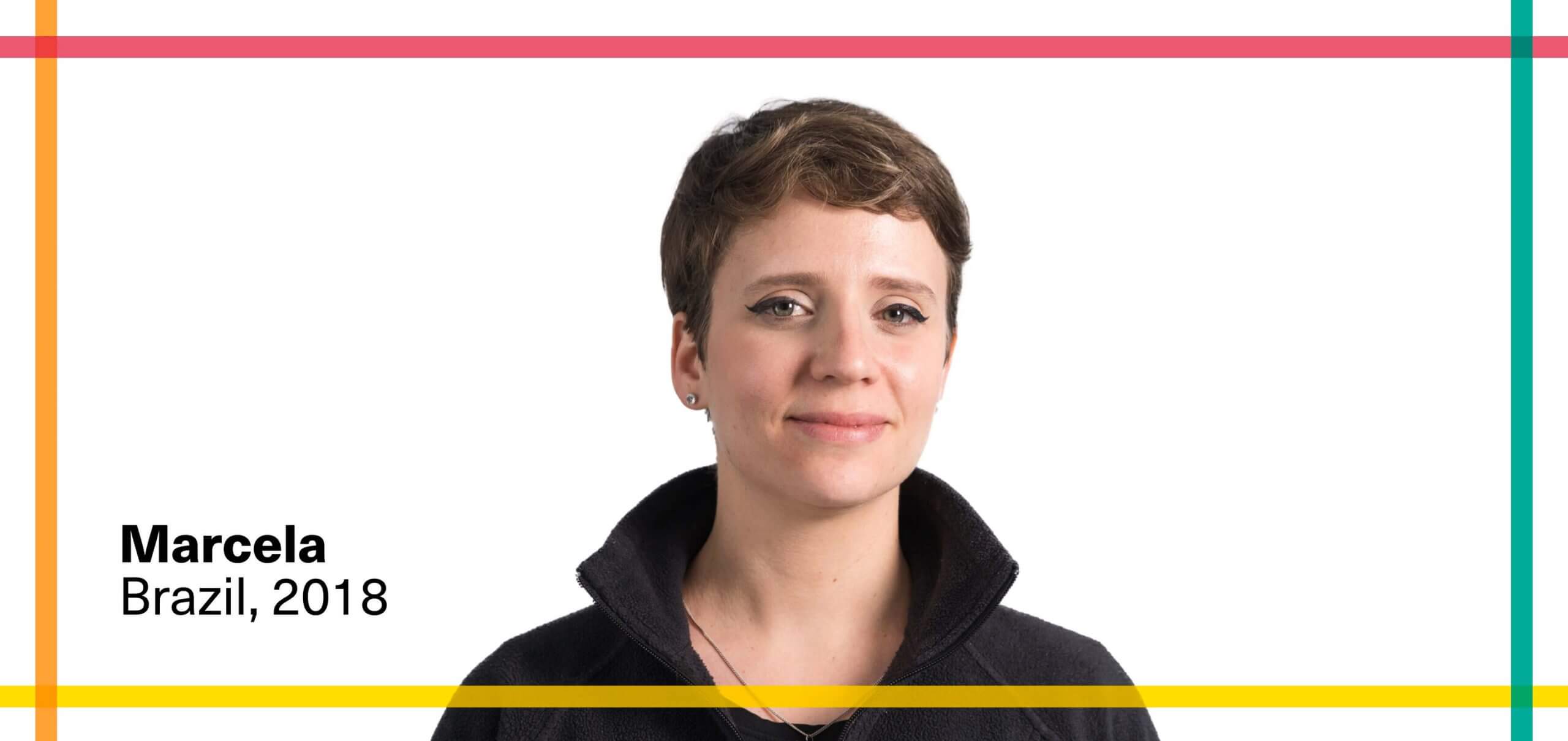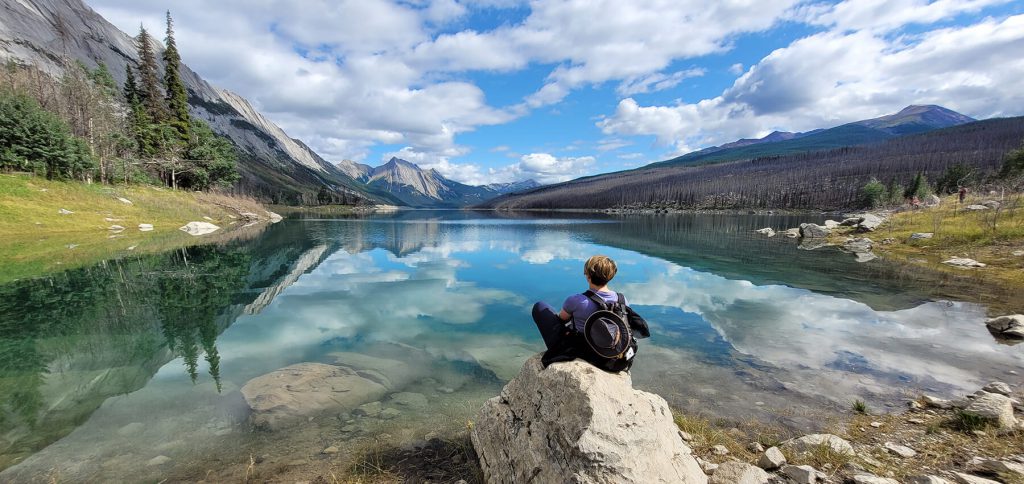From an interview with Marcela Havandjian Begalli
Marcela Begalli came to Canada from Brazil, where she studied industrial design and had an established career in advertising and design. She was interested in studying or working abroad, but on separate trips to Montreal and Toronto Marcela discovered something very different. Canada offered the opportunity to grow her career in UX design and strategy while finding a work life balance she had not enjoyed in Brazil. Marcela discusses the importance of creating a relationship with a place. As an avid hiker and kayaker Marcela takes us to the Canadian outdoors where she has made a connection with the natural space (even embracing winter hiking). Marcela also shares her understanding of the people, culture, and country she now calls home.
I’ve always liked to travel, but at a point I began to feel like travelling for vacation wasn’t enough. Even before I moved to Canada, I would visit a city and stay there for the whole 20 days of my trip. I wanted to experience what it would be like to live there—to just sit at a coffee shop and watch the people or go to a supermarket and then cook a meal. I started to get the itch: I wanted to live abroad.
I also needed a change professionally. São Paulo, and the advertising industry particularly, has a deep-rooted workaholic culture. There’s a lot of pressure when it comes to “making it.” It’s highly competitive and people regularly work 15 hours a day. I have friends who are lawyers and teachers and it’s the same: work, work, work. There’s an understanding that if you won’t do it, there are 10 people in line behind you who will. It’s difficult to have a good work-life balance in this environment.
I started doing some research to figure out how I could make living abroad work. I wasn’t necessarily thinking of moving abroad permanently. I wanted to have the experience to see what would happen. One option was to study abroad: I considered Italy and the U.K. Then I came on a trip to Montreal in 2015 to scout out McGill and Concordia universities, and I fell in love with the city.
Montreal is really special culturally; there’s so much going on. The first night I stayed at an Airbnb in Plateau-Mont-Royal, right in the heart of the city. Yet when I woke up, I opened the door and stopped in my tracks because of the silence. I could hear the wind in the trees. I felt at peace, and I thought, “Maybe I want to live here.” I could have tranquillity without giving up culture.
On a separate trip, I visited Toronto and realized I could have all the things I wanted in a city without 30 million people and all the traffic and hassle that comes with it. A friend told me that I had the exact kind of profile that the Canadian immigration program was looking for. They said, “If your idea is to experience living abroad, why don’t you just apply? And then you can decide if you want to study, if you want to work, or whatever.”
I really liked this approach, because in my Brazilian mindset, the idea of stopping work to study for a year felt like too much. This way, I wouldn’t have to pause my career to have the experience. I came to Canada via Express Entry as a Federal Skilled Worker. I spoke English and I spoke French (not fluently, but well) and my work experience was in the high demand area of industrial design.
I had more professional connections in Toronto than Montreal, and my level of comfort with English made it easier to transition, to make friends, and to do everyday tasks like calling a taxi. Now I live in Toronto. I share a house with two housemates in a quiet neighbourhood with tree-lined streets and lots of outdoor space. I’ve lived in condos my whole life, so to have a little garden is really wonderful.
Discovering Toronto and beyond
When you immigrate somewhere, it is important to create a relationship to that place. Part of it is cultural—getting to know the people—and also, on a larger scale, to understand the country. For me, it was important to also get to know the land, to learn about this environment, to make a connection to the natural place. The cultural scene in Toronto is great. There are restaurants, galleries, museums, and festivals. But, for a city of its size, the access to nature that Toronto offers is pretty wild: there are ravines and natural parks, trails and bike paths, beaches and Toronto Island. In 15 minutes, I can be in a kayak paddling on Lake Ontario.
There are even more trails around the Greater Toronto and Hamilton Area (GTHA), just north of the city and beyond. I have hiked many of them. For example, the Bruce Trail is Canada’s oldest and longest marked footpath, with 900 km of trails stretching from Niagara to Tobermory. I became a member of the Bruce Trail Conservancy. They maintain and steward these amazing trails. Also, they organize both car and bus hikes and if you don’t have a car, they pick you up at the subway station. If you’re a woman and, like me, you don’t want to hike alone, it’s a safe way to hike because you’re with a large group.
10 trails near Toronto:
- Spencer Creek Gorge
- Tew Falls
- Forks of the Credit
- Headwaters Trail at Dundas Valley
- Hilton Falls Conservation Area
- Rouge National Urban Park
- Chedoke Radial Trail
- Mono Cliffs Provincial Park
- Vicki Barron Lakeside Trail
- High Falls
Find more Ontario Trails Check out Parkbus
I love winter hiking. I actually like it even more than summer hiking. The aesthetic of snow and ice is so strange and beautiful. The atmosphere of hiking after a fresh snowfall is very special—it’s so quiet. Dress warmly and wear crampons on your boots so you don’t slip on the ice, and then just go for it.
Recently, my friends and I flew to Vancouver, we rented a car and drove to Jasper National Park in Alberta. It was eight or nine hours in the car, but it didn’t feel like it at all. The scenery was breathtaking. We drove to Canmore to do some exploring around the Banff National Park area.
When hiking in the wilderness, you must be really aware of yourself and of your environment. There are a lot of big animals in that part of Canada. You need to wear bells and carry bear repellent. When we were camping at Telegraph Cove on Vancouver Island, we had to be really careful because that area has the highest density of cougars in the world. I feel a little more relaxed hiking in Ontario, but there’s still so much more of Canada that I want to see.
Marcela’s top 5 tips for making it in Canada
1. Be a part of the place you’re in
If you’re new, you need to get to know your area. Be a part of wherever you are, part of the community that you’re in. I know people who come here and they choose to live in the middle of nowhere because it’s cheaper, and I understand that cost can be an issue. But don’t make it hard on yourself to get groceries and have casual encounters with people and do all the cultural activities.
2. Resist the temptation to be around people like you
It’s so easy to come here and just go into the neighbourhood where everybody speaks your native language and comes from your home culture. But it can really be limiting and pigeonhole you into a certain community. So look outside of your community.
3. Set up your life as if you mean to stay here
Get the phone, get the internet connection, get the insurance. Don’t cheap out on stuff that might be a problem for you in the future. Set yourself up properly from the start, because you’re in it for the long run.
4. Understand Canada and be informed
Read the news. Not from Facebook—get a newspaper and read it so that you really understand what is happening in Canada. One of the first things that I did when I arrived was to get a subscription to a weekly newspaper. I read it religiously, because I’m going to become a Canadian citizen soon. I want to vote, so I want to be informed.
5. Put yourself out there
If you come from a culture where you don’t really cold message somebody on LinkedIn because it feels weird, get over that. Connect with people on LinkedIn because there is a very good chance that this person has been through the same thing that you’re going through. People here are very willing to chat and help you professionally. They truly want to pay it forward.
Moving to Canada is a choice you keep making
If somebody’s thinking about immigrating, I tell them it’s a great project and you’ll probably get in, but consider what this means to your life in the long run. This is not a light decision to make. It changes your entire life.
Immigration’s not for everyone. Leaving your whole life behind is difficult. I had this impression when I moved here that it was a choice that I made. And then as the months and years go by, I realize it’s a choice that I have to keep making. I have to keep choosing to be here. It’s not a one-and-done sort of thing.
Your bonds to home may become weaker, but they’re still there. Brazil is where my family is, where my heart is in many ways. You’re constantly reevaluating to make sure that your decision is worth it. For me, it’s very much worth it because the life that I have built for myself is better here. It’s healthier, and it’s more aligned to the things that I want to do and the kind of person I am.







